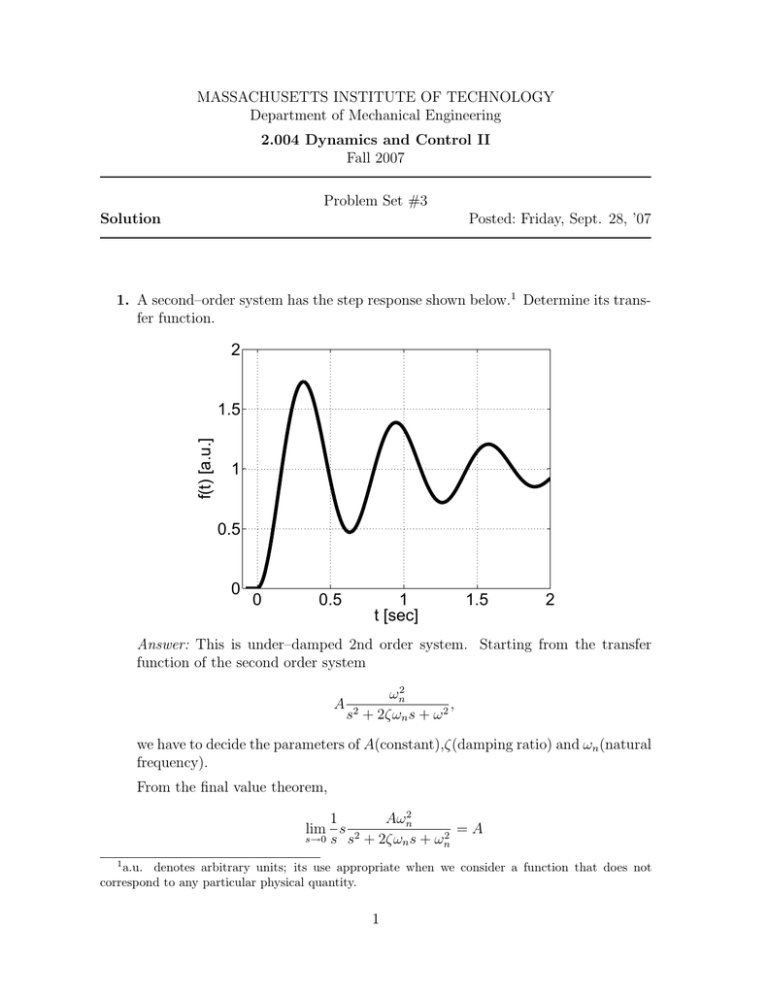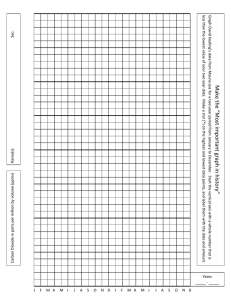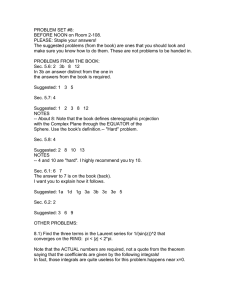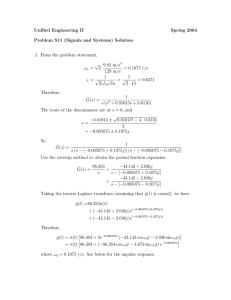Document 13664353
advertisement

MASSACHUSETTS INSTITUTE OF TECHNOLOGY
Department of Mechanical Engineering
2.004 Dynamics and Control II
Fall 2007
Problem Set #3
Solution
Posted: Friday, Sept. 28, ’07
1. A second–order system has the step response shown below.1 Determine its trans­
fer function.
2
f(t) [a.u.]
1.5
1
0.5
0
0
0.5
1
t [sec]
1.5
2
Answer: This is under–damped 2nd order system. Starting from the transfer
function of the second order system
A
ωn2
,
s2 + 2ζωn s + ω 2
we have to decide the parameters of A(constant),ζ(damping ratio) and ωn (natural
frequency).
From the final value theorem,
1
Aωn2
=A
lim s
2
s→0 s s2 + 2ζωn s + ωn
1
a.u. denotes arbitrary units; its use appropriate when we consider a function that does not
correspond to any particular physical quantity.
1
and the steady state value is 1 (from the given figure). Therefore, A = 1.
The step response of the under–damped second order system is
�
�
1 − ae−σd t cos (ωd t − φ) u(t),
where σd = ζωn and ωd = ωn
�
1 − ζ 2.
�
�
ζπ
From the lecture note 7 (pp. 26), %OS = exp − 1−ζ
: 72%.
2
Thus the damping ratio ζ ≈ 0.1.
To get the natural frequency, we choose two peak points at t1 = 0.35 sec and
t2 = 0.95 sec. The cosine term will be 1 at the peaks, so that we can consider
exponential decay term only.
f (t1 ) = 1 − ae−σd t1 = 1.72
f (t2 ) = 1 − ae−σd t2 = 1.4
Dividing the two equations, we obtain
ae−σd t1
1 − 1.72
=
.
−σ
t
1
d
ae
1 − 1.4
� � ��
From that σd = ln 0.72
/ {t2 − t1 } = 0.9796. Therefore ωn ≈ 9.8. (The reason
0.4
why I picked two points instead of one point is to cancel the constant a).
The transfer function is
64
,
+ 1.96s + 96
and its step response by MATLAB is
s2
Step Response
1.8
1.6
1.4
Amplitude
1.2
1
0.8
0.6
0.4
0.2
0
0
0.5
1
1.5
2
Time (sec)
Note that the estimated parameters might be slightly different than the original
because our reading of the plot can never be completely accurate.
2
2. Consider again the system of a DC motor with a parallel current source connected
via a gear pair to an inertia that we saw in Problem 5 of PS02. Substituting
numerical values is = 1.0u(t) A, R = 5 Ω, Km = 0.5 N · m/A, Kv = 0.5 V · sec,
Jm = 0.1 kg · m2 , (N2 /N1 ) = 10, J = 6 kg · m2 , K = 1 N · m/rad, derive and plot
the step response for the following two cases:
a) b = 9.4 N · m · sec/rad;
b) b = 0.76 N · m · sec/rad.
Answer:
The transfer function is
Θ(s)
(N2 /N1 )Km
�
�
�
=�
.
2
N
N
2
Is (s)
J +
N
22 Jm s
2 + b +
N
22 KvRKm s + K
1
1
Rearranging it, we can re–write it as
(N2 /N1 )Km
Θ(s)
=
Is (s)
K
s
2 +
K/(J + (N2 /N1 )2 Jm )
bR+(N22 /N12 )Kv Km
s
R(J+(N22 /N12 )Jm )
+
J +(N 2K/N 2 )Jm
2
.
1
The general form of the transfer function is
ωn2
Θ(s)
= A 2
,
Is (s)
s + 2ζωn s + ωn2
�
where the natural frequency ωn =
J+(N 2K/N 2 )Jm and the damping ratio ζ
=
2
bR+(N22 /N12 )Kv Km 1
.
R(J+(N22 /N12 )Jm ) 2ωn
1
a) b = 9.4 N · m · sec/rad;
ωn = 0.25 and ζ = 1.8 > 1. (Over–damped system) Transfer function is
5/16
Θ(s)
= 2
Is (s)
s + (14.4/16)s + (1/4)2
whose poles are p1 = −0.8242 and p2 = −0.0758. To obtain its step re­
sponse, we do partial fraction expansion.
K2
K3
K1
ωn2
=
+
+
,
A 2
2
s + 2ζωn s + ωn
s
s + 0.8242 s + 0.0758
where K1 = 5, K2 = 0.5067, K3 = −5.5067. The step response is
f (t) = (K1 + K2 e−0.8242t + K3 e−0.0758t )u(t).
3
Step Response
5
4.5
4
3.5
θ(t) [rad]
3
2.5
2
1.5
1
0.5
0
0
10
20
30
40
50
60
70
80
t [sec] (sec)
b) b = 0.76 N · m · sec/rad.
ωn = 0.25 and ζ = 0.72 < 1. (Under–damped system) The transfer function
is
5/16
Θ(s)
= 2
Is (s)
s + (5.76/16)s + (1/4)2
whose poles are p1 = −0.18 + j0.1735 and p1 = −0.18 − j0.1735. Doing
partial fraction expansion, we obtain
A
K2 s + K3
K1
ωn2
=
+ 2
,
2
2
s + 2ζωn s + ωn
s
s + 2ζωn s + ωn2
where K1 = 5, K2 = −5, K3 = −1.8. The step response is
f (t) = (K1 + K2 e−σd t cos(ωd t) + K3 e−σd t sin(ωd t))u(t).
Step Response
6
5
θ(t) [rad]
4
3
2
1
0
0
5
10
15
20
t [sec] (sec)
4
25
30
35
3. Problem 8 from Nise textbook, Chapter 4 (page 234).
Answer: Plotting the step response was not required; we did it here
for completeness.
a) T (s) =
2
s+2
Answer:
Pole: p=-2,
Zero: none
Pole−Zero Map
Step Response
2
1.5
1
0.8
0.5
Amplitude
Imaginary Axis
1
0
−0.5
0.6
0.4
−1
0.2
−1.5
−2
−4
−3
−2
−1
0
0
0
0.5
1
Real Axis
1.5
2
2.5
3
2
2.5
3
Time (sec)
Step response (1 − e−2t )u(t). 1st order system.
b) T (s) =
5
(s+2)(s+6)
Answer:
Poles: p1 = −2, p2 = −6,
Zero: none
Pole−Zero Map
Step Response
2
0.45
0.4
1.5
0.35
0.3
0.5
Amplitude
Imaginary Axis
1
0
−0.5
0.2
0.15
−1
0.1
−1.5
−2
−8
0.25
0.05
−6
−4
−2
0
0
0
Real Axis
0.5
1
1.5
Time (sec)
√
2
ωn
= 12 and ζ = 4/ 12 = 1.15 > 1. 2nd order overdamped system.
Step response [1 + K1 e−p1 t + K2 e−p2 t ] u(t).
c) T (s) =
10(s+7)
(s+10)(s+20)
Answer:
Poles: p1 = −10, p2 = −20, Zeros: z1 = −7
5
Step Response
0.4
1.5
0.35
1
0.3
0.5
0.25
Amplitude
Imaginary Axis
Pole−Zero Map
2
0
0.2
−0.5
0.15
−1
0.1
−1.5
0.05
−2
−35
−30
−25
−20
−15
−10
−5
0
0
0
0.1
Real Axis
0.2
0.3
0.4
Time (sec)
√
ωn2 = 200 and ζ = 30/2/ 200 = 1.06 > 1. 2nd order overdamped system.
Step response [1 + K1 e−p1 t + K2 e−p2 t ] u(t).
d) T (s) =
20
s2 +6s+144
Answer:
Poles: p1 = −3 + j11.619, p2 = −3 − j11.619, Zeros: none
Pole−Zero Map
Step Response
15
0.25
10
0.2
Amplitude
Imaginary Axis
5
0
0.15
0.1
−5
0.05
−10
−15
−4
−3
−2
−1
0
0
0
0.5
Real Axis
1
1.5
2
Time (sec)
√
ωn2 = 144 and ζ = 6/2/ 144 = 0.25 < 1. 2nd order underdamped system.
Step response [1 − Ae−σd t cos (ωd t − φ)] u(t).
e) T (s) =
s+2
s2 +9
Answer:
Poles: p1 = 3j, p2 = −3j, Zero: z = −2
6
Pole−Zero Map
Step Response
4
0.7
3
0.6
0.5
0.4
1
Amplitude
Imaginary Axis
2
0
−1
0.2
0.1
−2
0
−3
−4
−3
0.3
−0.1
−2.5
−2
−1.5
−1
−0.5
0
−0.2
0
0.5
5
10
Real Axis
15
20
Time (sec)
ωn2 = 9 and ζ = 0. 2nd order undamped system.
Step response [1 − K1 sin (3t) + K2 cos (3t)] u(t).
f ) T (s) =
(s+5)
(s+10)2
Answer:
Poles: p = −10(double), Zeors: z = −5
Pole−Zero Map
Step Response
2
0.06
1.5
0.05
0.04
0.5
Amplitude
Imaginary Axis
1
0
−0.5
0.03
0.02
−1
0.01
−1.5
−2
−12
−10
−8
−6
−4
−2
0
0
0
0.1
Real Axis
0.2
0.3
0.4
Time (sec)
ωn2 = 100 and ζ = 1. 2nd order critically damped system.
Step response [K0 + K1 e−10t − K2 te−10t ] u(t).
7
0.5
0.6
0.7





